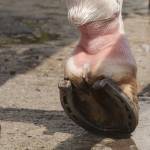Pastern Dermatitis in Horses

Suppose your horse has crusty skin or scabs on the back of his pasterns. It’s no big deal, right? Simply reach into the depths of your medicine chest for that tub of salve that promises to heal all manner of skin problems. All fixed! In many cases of pastern dermatitis, though, store-bought anodynes won’t work, and lesions can worsen, causing frustration, discomfort, and other health problems that can threaten the soundness and usefulness of the horse.
“Pastern dermatitis simply refers to redness, irritation, crusting, and hair loss on the posterior aspect, or back, of the pasterns. There are actually multiple causes of this condition, including bacteria, fungi, and mites. As such, there is no single cure for dermatitis,” explained Laura Petroski-Rose, B.V.M.S., a veterinarian with Kentucky Equine Research. Pastern dermatitis is also referred to as scratches, mud fever, and greasy heel.
According to a recent study, knowing the exact cause of the underlying dermatitis will facilitate and expedite treatment.* To identify the most common causes, a group of veterinary researchers recruited 15 horses with pastern dermatitis and eight healthy horses. A newly developed DNA-based test for detecting the bacterium Dermatophilus congolensis, widely assumed to cause pastern dermatitis, microscopic analysis of skin scrapings, and complete physical examinations were performed on all horses.
“The veterinary researchers found that, despite being thought of as a common cause of pastern dermatitis, Dermatophilus congolensis was identified in only one of the horses with pastern dermatitis,” Petroski-Rose said.
She added, “In contrast, the miniscule mite Chorioptes equi was far more prevalent, particularly in feathered horses.” Feathers are long hairs that grow on the legs of some horses, especially those with draft heritage.
In total, 4 of the 15 affected horses (all feathered) had chorioptic mange, and none of the horses had any evidence of a fungal infection.
Treatment for mites and bacteria differ, making early diagnosis and targeted treatment by a veterinarian more preferable than presumptive treatment by the owner. This is especially true considering mites are not typically visible to the naked eye, and Dermatophilus congolensis can easily spread to humans.
In horses recovering from pastern dermatitis, nutritional supplements designed to bolster skin health would be advantageous.
“Kentucky Equine Research offers EO-3, a potent marine-derived oil rich in omega-3 fatty acids, notably DHA and EPA. In addition to supporting healthy skin and coat, the natural anti-inflammatory effects of EO-3 could help during the healing phases of pastern dermatitis,” advised Petroski-Rose.
Owners may also wish to consider supplementing with Bio-Bloom PS (Bio-Bloom HF in Australia), a two-in-one hoof and coat conditioner that contains biotin, methionine, and other ingredients that support the integumentary system.
*Aufox, E.E., L.A. Frank, E.R. May, et al. 2018. The prevalence of Dermatophilus congolensis in horses with pastern dermatitis using PCR to diagnose infection in a population of horses in southern USA. Veterinary Dermatology 29(5):435-e144.








